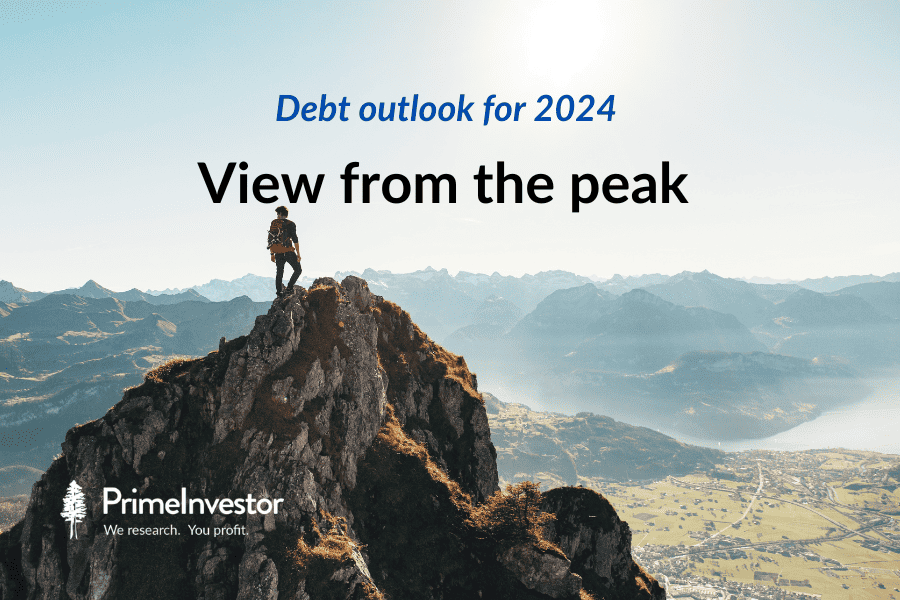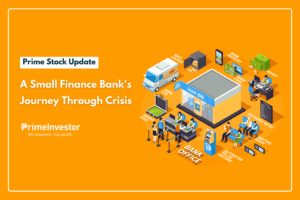Calling the top or bottom in any asset class can go badly wrong. Therefore, we’re pleased that PrimeInvestor’s call in January last year that interest rates in India were set to top out soon, did come good.
The Monetary Policy Committee (MPC) began 2023 at a repo rate of 6.25%, hiked it 6.50% in February, and stayed on pause thereafter. The 10-year government security peaked at 7.45% in early March, dipped and has remained range-bound between 6.96% and 7.45% since then.

There was however one trend we missed. We did not foresee that interest rates on short-term debt options would keep sprinting and get ahead of medium-term debt options. This made the returns on money market funds and low duration funds match those on gilt and medium duration funds in 2023. Of course, we managed to catch the trend a bit later adding more shorter duration with – HDFC Low Duration and ICICI Pru Banking & PSU Debt in our September 2023 review of Prime Funds.
Here’s our reading of debt markets and where opportunities may lie for Indian debt investors in 2024.
#1 Rate cuts may be delayed
Now that rates have stopped going up, they must give in to gravity and go down. That’s what markets seem to think, but we are a bit sceptical. While bond markets are priming for rate cuts early in 2024, we think that policy rate cuts by MPC can be deferred to the end of 2024 or even 2025.
Three factors back this view.
One, the MPC has been keeping a close eye on inflation trajectory and repeatedly reminding markets that its inflation target is 4% and not 6%. The CPI inflation rate, after peaking at 7.44% in July 2023 has dipped to 5.55% by November, but has not shown any signs of heading towards the 4% mark.
Two, the MPC would be pressured to cut rates soon if economic growth were stalling. But the Indian economy has been delivering better than expected growth lately, with the latest print at 7.6% for Q2 FY24.
Three, before zero interest rates and Quantitative Easing became the norm globally, India’s repo rates used to swing between 6% and 8%. 6.5% is therefore quite a moderate level for the repo rate.
We also believe that the inflation threat is not yet behind us. Inflation in India has been subject to periodic flare-ups from oil and food prices. Global crude oil prices have tumbled in the last six months with the Brent now below $80 mark, so that’s not a threat to inflation right now.
But with the El Nino that arrived in February 2023 threatening to stay on until June 2024, food inflation remains a risk. The kharif agricultural season for India was below-par. With erratic rains resulting in poor reservoir storage, rabi prospects are not too bright either. This suggests that 2024 may continue to see sudden spurts in the prices of agri-commodities. This will keep up pressure on the RBI and MPC to keep rates at current levels until the El Nino threat is behind. This could mean rate cuts being deferred to the fag end of 2024 or early 2025.
While global markets seem to be preparing for the US Fed to begin its rate cuts as early as March, that seems over-optimistic too. In any case, India’s MPC has not followed very faithfully in the Fed’s steps of late. Only a series of Fed rate cuts would influence MPC to follow suit.
Opportunity: For investors, deferred rate cuts effectively mean that recent bets on 10-year constant maturity funds or long duration gilts may not pay off immediately. In any case, these investments are only recommended for a 5-year plus holding period.
#2 Opportunity in short debt
While the repo rate has not been hiked since February 2023, RBI has used other weapons to keep inflation in check. It has deliberately kept liquidity tight in the banking system as a backdoor means to keep short-term borrowing costs high (speculation in agri-commodities is fuelled by short-term borrowings). Markets expected RBI to open the money taps, after withdrawing the excess liquidity injected during Covid. But it has moved in the opposite direction.
In August RBI mandated an incremental Cash Reserve Ratio of 10% for banks, sucking over Rs 1 lakh crore out of the banking system. When that measure was to be phased out in October, it announced Open Market Operations (OMO) to mop up excess liquidity.
While OMOs have not been conducted, the liquidity deficit in money markets which began in September 2023 (after 4 years) has persisted for the last three months. MPC statements have continued to emphasise on ‘withdrawal of accommodation’ suggesting that tight liquidity would remain in place for the foreseeable future.
Tight liquidity conditions amid soaring appetite for credit have led to a scramble for short term funds among banks, NBFCs and corporates borrowing in the commercial paper and bond markets. This is why we’ve been seeing banks offering higher FD rates for 1-2 year terms, NBFCs trying to raise short term money at high yields and high yields even from A1 borrowers in the commercial paper market.
The table below, which captures yield movements in the last one year, show how yields on treasury bills and short-term corporate borrowings for upto 1 year tenors have shot up, even as those on 3-year plus instruments have stayed flat or moderated. We expect the tight liquidity and elevated short-term rates to stay in place until the Lok Sabha elections, as inflation control will remain a priority.
Given that the price gains from long-duration debt may take time to pay off, while excellent opportunities are cropping up at the short-end, debt investors may need to consider a barbell strategy this year (What’s a barbell? Read this article by PrimeInvestor on ladders, barbells and roll-downs)
Opportunity: They may need to divide their debt investments, so that only investments with a 5-year plus horizon are in constant maturity, gilt, medium-term (corporate bonds) or long-duration funds. For the rest, low-duration and short-duration debt funds can be a good bet, to check into prevailing high spreads on short-term corporate bonds and commercial paper. Some funds in these categories now boast a portfolio yield-to-maturity of 7.8-8%. Check out Prime Funds for scheme-specific recommendations.
# 3 Market may pre-empt MPC
Like stock markets, bond markets usually pre-empt policy action. Therefore, we expect yields on 10 year-plus bonds in India to begin their descent before the MPC flags off its first rate cut.
One big event that will help this process along is the inclusion of Indian g-secs in the JP Morgan EBI Global Bond Index. We analysed its impact in detail in this previous article: JP Morgan India’s inclusion of Indian g-secs in index. But to cut a long story short, here’s a summary:
- Indian g-secs will begin to be added into the index in 1% doses per month from June 28 2024, going up to the full 10% by March 31 2025. Estimates of how much money can flow in range from $21 billion to $40 billion. This is just 12% of the Indian government’s annual g-sec issues.
- But given that the Indian debt market is quite shallow and that only eligible g-secs of 10-year plus tenures can get these flows, we can expect the higher flows to prop up prices and liquidity for the chosen g-secs.
- FPIs looking to make a quick buck off this inclusion may take positions in Indian g-sec markets ahead of June 28 2024. This is why we think that irrespective of what the MPC does, the yield on long-dated g-secs in India will trend down this year. The 10-year is unlikely to hold at 7.5% for any length of time.
Opportunity: If you’ve been waiting to park 5-year plus money in constant maturity or long duration funds, the window of opportunity is short, even though its results might be a bit delayed. Ditto for direct investments in long-term g-secs or SDLs.
Retirees looking at annuity plans must take a hard look at recent issuances of 15-30-year g-secs and SDLs at yields of 7.4%-7.8%.
# 4 Shift to quality
Last year, we flagged that widening credit spreads on A and AA rated corporate bonds compared to AAA bonds, offered an opportunity to explore high-yield bonds and credit risk funds. We kept a close watch on bond markets and highlighted opportunities to buy into high-yield NCDs from CreditAccess Grameen, Cholamandalam Investment and other options.
But as spreads for lower-rated corporate bonds over AAA has now narrowed, we believe that it makes more sense for investors today to stick with corporate bond funds which invest in high-quality securities unless the yields make up for the risk and the time frame is not long (we will sound off such opportunities if we find them convincing).
Investing in funds with portfolio maturity of 3-5 years can help investors lock into prevailing high corporate bond spreads. PSU and banking debt funds also offer a combination of high yield and low risk, as the improving fundamentals of PSUs and healthy bank balance sheets argue for these spreads to narrow over time. Look out for recommendations from these categories in Prime Funds.
Whenever any category of borrowers in India becomes the hot favourite for banks and NBFCs, defaults and bad loans in that segment have a habit of ballooning. With a scorching pace of credit growth in retail loans, both banks and NBFCs in hot pursuit of retail borrowers and newfangled digital lending models wooing newbies, we are getting a bit wary of this segment.
RBI’s recent comments in its Financial Stability Report and its attempt to curb banks and NBFCs offering unsecured retail loans by jacking up risk weights show that the regulator is worried about this segment too.
Even if there isn’t an actual bubble building up in unsecured retail loans, regulatory moves by RBI can choke off funding to the smaller NBFCs engaged in this business and escalate risks for NCD investors.
Opportunity: Today, online bond platforms are choc-a-block with NCD offers from less-known NBFCs offering double-digit yields. We think that this is segments is getting riskier for retail investors to dabble in. Investing in NBFC NCDs with yield as the sole metric can turn out to be a quagmire. We apply pretty stringent filters to our NBFC NCD recommendations deep-diving into the lending segments, business fundamentals and management. We will continue to scout for opportunities that compensate for the risk taken but our calls on this segment may not be too many. You can cherry-pick your bond investments from our calls made in Prime Bonds (available for Prime Growth subscribers).
#5 Lock into long term FDs
The scramble for liquidity at the short end of the debt market has had banks and NBFCs hike their rates for up to 3-year deposits. But we believe that FD rates for 3-year plus tenures are unlikely to head higher with market interest rates heading South.
Rates on small savings schemes are supposed to follow gilts. But they’ve been delinked from that peg lately. We think that interest rates on long-term small savings schemes such as NSC, Kisan Vikas Patra and PPF may have peaked in this cycle.
Opportunity: If you are an investor or senior dependent on FDs for regular income, it makes sense to stop waiting and to lock into 4-5 year FDs from banks and NBFCs, even if the rates on these tenures are slightly lower than those on up to 3 year options. Staying with short term options now will expose you to re-investment risk, as you may find rates on longer term options declining before you can make the switch.








22 thoughts on “Debt outlook for 2024: View from the peak ”
Thank you for the article.
What is your opinion on Floating Rate funds for 2024 ??
Their performance will begin to slow down after rate cuts take effect. This will be captured in Prime quarterly reviews. But there’s time yet as there is a lag between rate revision and that reflecting in floating rate secs like govt FRBs.
Thank you for a very informative article. For someone currently invested in Debt MF (corporate bond ,constant maturity,short term), is it advisable to move some or most of it to bank FDs once the investment has crossed 3 years? Thank you, Regards
Thanks. Such a switch is not needed unless the returns of the scheme really lag FDs. MFs still allow you to defer your tax payout to redemption while FDs require you to pay tax on returns every year.
Thank you!
Hi, can Corporate and Government debt part of NPS tier 2 be used to take benefit of higher rates and may be decrease in interest rates later this year/next year?
NPS C and G have no fixed mandate about investing in long duration bonds. So MFs are better.
A person around 60-62 yrs , why he should not lock funds in 30 yrs G sec to enjoy higher interest rate with absolute security as expected life span now is easily 85+ ? You avoid the risk of lower interest rate in future, protected against expected general lower interest rate in future as economy develops. Of course for net 4/5 yrs there will be some loss as 5yrs NBFC rates are about 1% higher than what G sec offers.
Your views please.
Yes you are absolutely right. We have in fact recommended this in one of our earlier articles. :-) The only minus is that you can’t exit before maturity as liquidity is currently low in these long term gsecs. But gsecs are definitely a better alternative to annuity plans from insurers!
Can u help me with your earlier article?
Not sure which earlier article you mean sir. Vidya
Rate cuts may happen sooner than expected due to upcoming Lok Sabha elections. Higher Home Loan emis have definitely become a talking point and the government may ask RBI to try to soothe the nerves by going for a rate cut.
This is our view and we may be wrong.
Hello Mam,
Thank you for the detailed & comprehensive debt
market outlook for 2024. Can I invest in ICICI Pru. constant maturity fund instead of prime
recommended SBI constant maturity fund ( for 5 year plus horizon ) since it has a lower expense ratio or am I missing something here.
It has a shorter track record. Reason we picked SBI is its rolling return record.
Hi Aarati …
Informative article, as always.
Rate cut may be a year away but prime fund like SBI Magnum Constant Maturity Fund has YTM of 7.33%. Does it not make sense to enjoy high YTM till then and when rate cut materialises, make hondsome capital gains too of ~ 9% … Over say… 2 years period..?
Regards … Jatin
Yes that’s a workable strategy.
Hello,
Nice article and very informative….
Last time you recommended Credit Risk Funds as the spread AA v/s AAA was good. Now it has reduced. What do investors do wrt to ICICI Pru Credit Risk fund that was just invested 1+ yr ago? Also, for fresh money are you suggesting no fresh money into ICICI Pru Credit Risk funds?
Understand abt low rated NCDs, smaller banks that offer 9% or more interest rate are quite risky… i tend to stay away from them anyways….
Thank you…Amit
Yes we feel corporate bond funds make more sense than credit risk funds for fresh investments.
I completely like the post and agree with it. Pretty timely as I was thinking of my approach.
I have a question (I know there’s some crystal ball gazing here…).
Let’s say if I am going to be a senior citizen in a year from now, should I lock in now to FD rates (from say SFB) or move my funds on a 364 day Treasury bill and then open the FD next year (as you generally get about 0.5% more for a senior citizen?)
This excludes the other avenues I have a plan for (PO, SCSS, RBI Floating Rate Bonds).
As we have written in the article it may be better to lock into long tenure FDs now rather than wait a year.
Hi Madam,
Very insightful about debt markets..
Thank you, Vijay
Comments are closed.